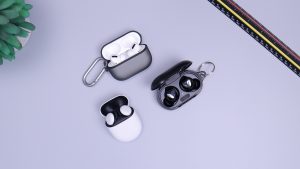Checking Compatibility
Before attempting to connect your JBL speaker to your Samsung TV, it's crucial to ensure that the devices are compatible. Here's what you need to consider:
-
Bluetooth Compatibility: Check if your Samsung TV has Bluetooth capabilities. Not all Samsung TVs are equipped with Bluetooth, especially older models. To verify this, refer to the TV's user manual or navigate to the settings menu on the TV to search for Bluetooth options. If your TV lacks Bluetooth functionality, you won't be able to connect your JBL speaker wirelessly.
-
HDMI ARC: Determine if your Samsung TV features an HDMI ARC (Audio Return Channel) port. This technology allows audio to be sent from the TV to an external audio device, such as a soundbar or speaker, through the HDMI cable. Look for the "ARC" label next to one of the HDMI ports on your TV. If your TV lacks an HDMI ARC port, you may need to explore alternative connection methods.
-
Audio Output Compatibility: Check the available audio output options on your Samsung TV. Common audio output ports include optical digital audio, analog audio (RCA), and the aforementioned HDMI ARC. Ensure that your JBL speaker has corresponding input options for seamless connectivity.
-
Power Compatibility: Confirm that your JBL speaker is powered and in good working condition. If the speaker requires a power source, ensure it's plugged in and ready to pair with your TV.
-
Software Updates: Check for any available software updates for both your Samsung TV and JBL speaker. Ensuring that both devices are running the latest firmware can potentially resolve compatibility issues and improve the overall user experience.
By carefully assessing these compatibility factors, you can set the stage for a successful connection between your JBL speaker and Samsung TV. Once you've confirmed compatibility, you can proceed with the appropriate connection method based on the available options.
Connecting via Bluetooth
If your Samsung TV is equipped with Bluetooth functionality and your JBL speaker supports wireless connectivity, establishing a Bluetooth connection is a convenient option. Here’s a step-by-step guide to pair your JBL speaker with your Samsung TV via Bluetooth:
-
Enable Bluetooth on Your Samsung TV: Access the settings menu on your Samsung TV and navigate to the Bluetooth settings. Activate the Bluetooth feature and ensure that your TV is discoverable.
-
Put Your JBL Speaker in Pairing Mode: Refer to the user manual of your JBL speaker to understand how to initiate the pairing mode. Typically, this involves pressing and holding a specific button or combination of buttons on the speaker until the pairing indicator light starts flashing.
-
Pairing the Devices: Once your JBL speaker is in pairing mode, use your Samsung TV to search for available Bluetooth devices. Locate your JBL speaker in the list of available devices and select it to initiate the pairing process.
-
Confirmation and Testing: After successfully pairing the devices, confirm that the TV’s audio is now being transmitted to the JBL speaker. Play a sample video or audio clip on your TV to test the audio output through the connected JBL speaker.
It’s important to note that the Bluetooth range between the TV and the JBL speaker may vary based on environmental factors and the specific Bluetooth version supported by your devices. Additionally, some Samsung TVs may have limitations on the types of audio that can be transmitted via Bluetooth, so be mindful of the supported audio formats.
By following these steps, you can seamlessly connect your JBL speaker to your Samsung TV via Bluetooth, enhancing your audio experience without the constraints of physical cables.
Connecting via HDMI
If your Samsung TV and JBL speaker are equipped with HDMI connectivity options, establishing a connection using an HDMI cable can deliver high-quality audio output. Follow these steps to connect your JBL speaker to your Samsung TV via HDMI:
-
Locate the HDMI ARC Port: Identify the HDMI ARC (Audio Return Channel) port on your Samsung TV. It is typically labeled as "ARC" and allows for two-way communication between the TV and an external audio device, such as a soundbar or speaker.
-
Connect the HDMI Cable: Use a high-speed HDMI cable to connect the HDMI ARC port on your TV to the HDMI ARC input on your JBL speaker. Ensure that the cable is securely plugged into both devices to establish a reliable connection.
-
Configure TV Settings: Access the audio settings on your Samsung TV and select the HDMI ARC input as the audio output source. This step ensures that the audio from the TV is transmitted to the connected JBL speaker via the HDMI connection.
-
Testing the Connection: Play a video or audio content on your TV to confirm that the audio is being transmitted to the JBL speaker via the HDMI connection. Adjust the volume and ensure that the audio output is clear and synchronized with the video playback.
Connecting your JBL speaker to your Samsung TV via HDMI offers a direct and efficient audio transmission method, leveraging the advanced capabilities of HDMI technology. This setup can enhance your viewing experience by delivering immersive audio output through your JBL speaker.
Connecting via Audio Cable
When Bluetooth or HDMI connectivity options are unavailable or unsuitable for your setup, using an audio cable to connect your JBL speaker to your Samsung TV is a reliable alternative. Follow these steps to establish a wired connection using an audio cable:
-
Identify Audio Output Ports: Locate the audio output ports on your Samsung TV. Common options include optical digital audio, analog audio (RCA), or a 3.5mm headphone jack. Choose the output port that is compatible with your JBL speaker’s input options.
-
Select the Appropriate Cable: Depending on the available audio output port on your TV and the input options on your JBL speaker, select the corresponding audio cable. For example, if your TV has an optical digital audio output, use a TOSLINK optical cable. If the TV has RCA output, use an RCA-to-3.5mm cable or RCA-to-RCA cable, based on the speaker’s input requirements.
-
Connect the Cable: Plug one end of the audio cable into the selected audio output port on your Samsung TV and the other end into the corresponding input port on your JBL speaker. Ensure a secure and snug connection to prevent audio distortion or signal loss.
-
Configure TV Audio Settings: Access the audio settings on your Samsung TV and designate the connected audio output port as the primary audio source. This step ensures that the TV’s audio is routed through the connected JBL speaker via the audio cable.
-
Testing the Audio Output: Play a video or audio content on your TV to verify that the audio is being transmitted to the JBL speaker through the audio cable. Adjust the volume levels and ensure that the audio output is clear and synchronized with the visual content.
By utilizing an audio cable to connect your JBL speaker to your Samsung TV, you can establish a stable and direct audio transmission path, ensuring consistent and high-quality sound reproduction without relying on wireless connections.
Troubleshooting Common Issues
While connecting your JBL speaker to your Samsung TV, you may encounter common issues that can impede the seamless operation of the audio setup. Here are some troubleshooting steps to address potential challenges:
-
Bluetooth Pairing Failures: If you encounter difficulties pairing your JBL speaker with your Samsung TV via Bluetooth, ensure that the speaker is sufficiently charged and within close proximity to the TV during the pairing process. Additionally, power cycle both devices and attempt the pairing process again. If the issue persists, check for firmware updates for both the TV and the speaker to address potential compatibility issues.
-
Audio Delay or Synchronization Issues: When using wireless or wired connections, audio delay or synchronization problems may arise, causing a mismatch between the audio and video playback. Adjust the audio delay settings on your TV, if available, to synchronize the audio output with the video. For Bluetooth connections, ensure that the JBL speaker is using the appropriate Bluetooth codec supported by your TV to minimize latency.
-
Audio Output Selection: If the audio is not being transmitted to the connected JBL speaker, verify that the correct audio output source is selected on your Samsung TV. Access the audio settings and ensure that the designated output port, whether Bluetooth, HDMI ARC, or the audio cable, is actively transmitting the audio signal to the JBL speaker.
-
Compatibility Checks: Revisit the compatibility factors, such as Bluetooth support, HDMI ARC availability, and audio output options, to confirm that the TV and JBL speaker are indeed compatible. Consult the user manuals for both devices and cross-reference their specifications to ensure seamless integration.
-
Environmental Interference: Wireless connections, particularly Bluetooth, may be susceptible to interference from other electronic devices or physical obstructions. Minimize potential sources of interference, such as other Bluetooth devices or dense obstacles, to optimize the wireless connectivity between your TV and JBL speaker.
By addressing these common issues and implementing the suggested troubleshooting steps, you can overcome connectivity challenges and optimize the audio connection between your JBL speaker and Samsung TV, ensuring a gratifying audiovisual experience.


